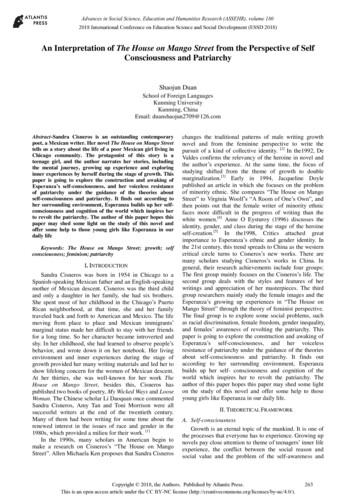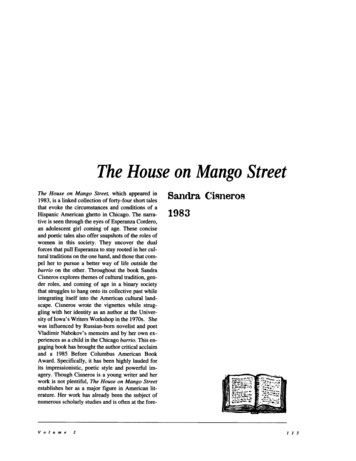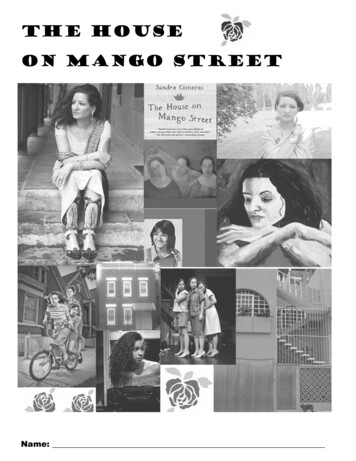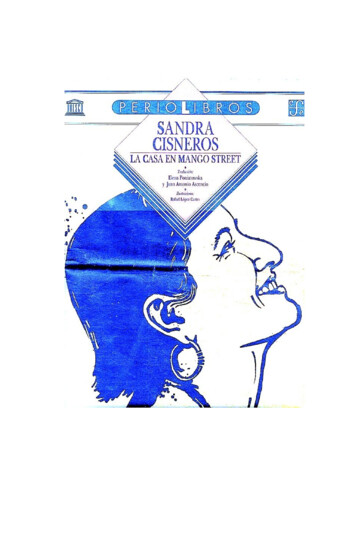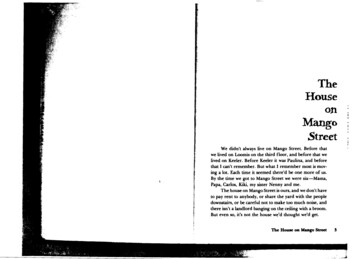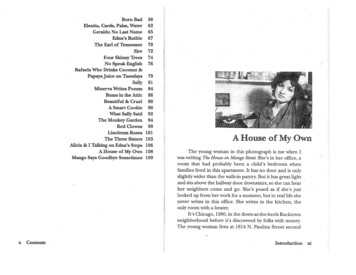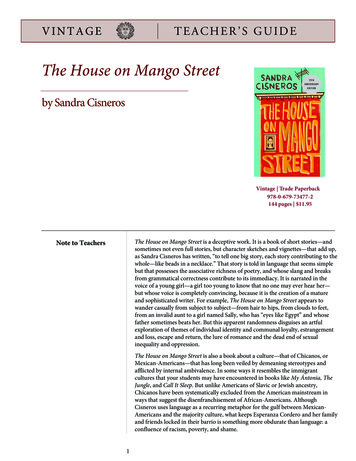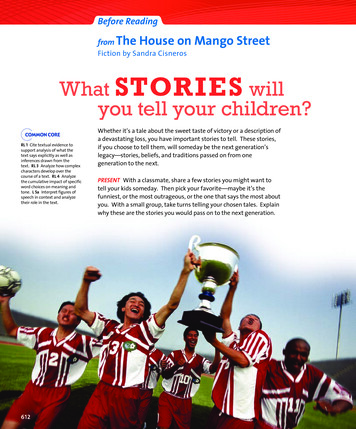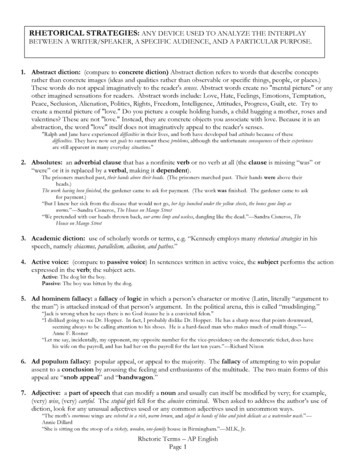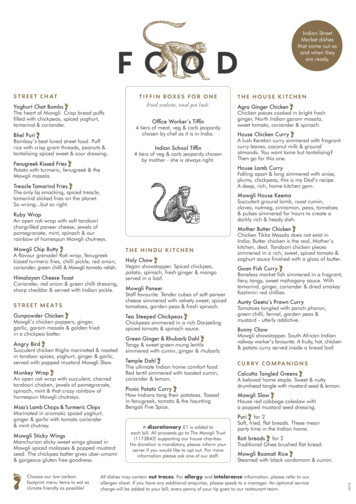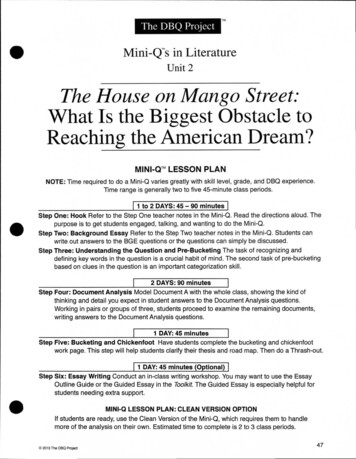
Transcription
TMThe DBQ Project Mini-Q"s in LiteratureUnit 2The House on Mango Street:What Is the Biggest Obstacle toReaching the American Dream?MINI-QTM LESSON PLANNOTE: Time required to do a Mini-Q varies greatly with skill level, grade, and DBQ experience.Time range is generally two to five 45-minute class periods. 1 to 2 DAYS: 45 — 90 minutesStep One: Hook Refer to the Step One teacher notes in the Mini-Q. Read the directions aloud. Thepurpose is to get students engaged, talking, and wanting to do the Mini-Q.Step Two: Background Essay Refer to the Step Two teacher notes in the Mini-Q. Students canwrite out answers to the BGE questions or the questions can simply be discussed.Step Three: Understanding the Question and Pre-Bucketing The task of recognizing anddefining key words in the question is a crucial habit of mind. The second task of pre-bucketingbased on clues in the question is an important categorization skill.2 DAYS: 90 minutesStep Four: Document Analysis Model Document A with the whole class, showing the kind ofthinking and detail you expect in student answers to the Document Analysis questions.Working in pairs or groups of three, students proceed to examine the remaining documents,writing answers to the Document Analysis questions.1 DAY: 45 minutesStep Five: Bucketing and Chickenfoot Have students complete the bucketing and chickenfootwork page. This step will help students clarify their thesis and road map. Then do a Thrash-out.1 DAY: 45 minutes (Optional)Step Six: Essay Writing Conduct an in-class writing workshop. You may want to use the EssayOutline Guide or the Guided Essay in the Toolkit. The Guided Essay is especially helpful forstudents needing extra support.MINI-Q LESSON PLAN: CLEAN VERSION OPTIONIf students are ready, use the Clean Version of the Mini-Q, which requires them to handlemore of the analysis on their own. Estimated time to complete is 2 to 3 class periods.D 2013 The DBQ Project47
The House on Mango Street Mini-QTEACHER DOCUMENT LIST (EV)There are four documents in this Mini-Q. Students are provided with a document list, but it is notdivided into analytical categories or buckets. Students may develop categories that are differentfrom these.Poverty:Document A: "The House on Mango Street"Document B: "A Smart Cookie"Language:Document C: "No Speak English"Discrimination:Document D: "Geraldo No Last Name"48 2013 The DBQ Project
The House on Mango Street Mini-QThe House on Mango Street:What Is the Biggest Obstacle toReaching the American Dream? Overview: Sandra Cisneros wrote The House on Mango Street in the early 1980s. The book presentsa series of related short stories, spun from observations and memories of the Latino neighborhoods ofChicago where Cisneros grew up. The characters on Mango Street may be unique, but their hopes anddreams are versions of a larger American Dream which has shaped this country since its creation.The Documents: Document A: "The House on Mango Street"Document B: "A Smart Cookie"Document C: "No Speak English"Document D: "Geraldo No Last Name"A Mini Document Based Question (Mini-Q)0 2013 The DBQ ProjectThis page may be reproduced for classroom use49
The House on Mango Street Mini Q-Step One: The HookTeacher Note: The purpose of the Hook is to create some initial interest in the Mini-Q. Working inpairs or groups of three, students will examine and answer questions about a cartoon that relatesto the American Dream. The whole class can then have a brief discussion during which theyshare their answers. Throughout, it is important that students know they are being asked to makeobservations and guesses, so there are no wrong answers. While a clearer understanding of theAmerican Dream may emerge during the Hook, please note that this term will be explicitly definedin the Background Essay which follows.Sample responses to Hook questions:1. Focus on the left side of the cartoon and the box of "American Dream Helper" on the shelf.What are the "ingredients" of the American Dream?The "ingredients" of the American Dream include a house in the suburbs, children, aminivan, leisure time, healthcare, and security.2. Now focus on the right side of the cartoon and the woman holding the box. What's thecatch? In other words, what's the fine print on the back of the box?The catch is that you need money in order to get the American Dream.3. Does this cartoon portray the American Dream positively or negatively? Explain yourthinking.I think the cartoon portrays the American Dream negatively. Based on the box of"American Dream Helper," the American Dream seems really great. The Dream is insuch easy reach; in fact, the woman is holding it in her hand. However, based on thesurprised and anxious expression on her face, she realizes how much attaining theDream will cost.50@ 2013 The DBQ Project
The House on Mango Street Mini Q- Hook Exercise: The American DreamDirections: Below is a cartoon which deals with an idea called the American Dream. In pairs orgroups of three, examine the cartoon and answer the questions that follow. Use evidence from thecartoon to explain your thinking.*Coor.miwAtel LIA-15ryie* Ha15E SISOMS* 2.5 ICP5 ANP MIVIV4Ai* Carlige RiaarioN*XFAL:HCA2wh SeCOnr9 1. Focus on the left side of the cartoon and the box of "American Dream Helper" on the shelf. Whatare the "ingredients" of the American Dream?2. Now focus on the right side of the cartoon and the woman holding the box. What's the catch? Inother words, what's the fine print on the back of the box? 3. Does this cartoon portray the American Dream positively or negatively? Explain your thinking.@ 2013 The DBQ ProjectThis page may be reproduced for classroom use51
The House on Mango Street Mini-QStep Two: Establishing the ContextGeneral Instructions Find Chicago on a map. Pre-teach the boldfaced vocabulary. Have students read, or read aloud to them, the Background Essay. Have students answer the Background Essay questions on the next page.Specific ConsiderationsThe main purpose of the Background Essay is to create a context for the Mini-Q exercise. Its jobis to set the backdrop for the question, and introduce important vocabulary and concepts. Doingthis well gives all students a more equal chance to succeed with the Mini-Q. We recommend that itnot be rushed. Also, consider reading the Background Essay aloud. We believe it is good for manystudents, even good readers, to hear the words as they see them. For many it is important to hearthe cadence of the language, to experience pauses and emphasis.Vocabulary and ConceptsYou may want to pre-teach the three boldfaced terms in the essay, but the term "American Dream"is directly defined in the essay itself. Our feeling about vocabulary is that some pre-teaching is goodbut keep the word list short. Even for English language learners, see how much they can get fromcontext. Understanding vocabulary is another reason for reading aloud.52 2013 The DBQ Project
Background EssayThe House on Mango Street Mini-QThe House on Mango Street:What Is the Biggest Obstacle to Reaching the American Dream?Cathy claims to be related to the queen of variations, but basically it is the chance for equalFrance. Meme Ortiz jumps out of a tree and opportunity. According to the American Dream,breaks both arms. Sally marries a marshmal- people of all backgrounds come to America andlow salesman before eighth grade. And so go the receive a good education, a well-paying job, anda house with a white-picket fence. They crelives of the people on Mango Street.The stories in The House on Mango Street, ate a better life for themselves and their chilsays author Sandra Cisneros, come together to dren. Many of the characters on Mango Streethave worked hard to"tell one big story,reach this dream, buteach story contributtheir stories are oftening to the whole—likemarked by disappointbeads on a necklace."ment. As CisnerosSome of the storieswrites, "Here there isare very short—a fewtoo much sadness andare only two or threenot enough sky."paragraphs—and theWhy can't thelanguage Cisneroscharacterson Mangouses can make themStreet simply leave befeel like poetry. Withhind their sadness andso many little storiesbeing told, what is theachieve their dreams?IsEsperanza longing"big story" about? Forfor too much when sheone, it is a coming-ofsays: "Do you wishage story that has paralyour feet would onelels to Cisneros's ownchildhood. Esperanza,day keep walking andthe narrator of Mangotake you far away fromPhotographofSandraCisnerosMango Street, far awayStreet, is a MexicanAmerican girl growingand maybe your feetup in a poor Chicagowould stop in front of aneighborhood. She tells us of her life, her fam- house, a nice one with flowers and big windowsily, her neighbors, even people she hears about and steps for you to climb up two by two upstairssecond-hand. Some of the people on Mango to where a room is waiting for you"?Street are Mexican-American like herself, andFor the people on Mango Street, it seemssome are recent immigrants from Mexico and that the American Dream has been replaced withother Spanish-speaking countries. Their stories sadness and a wish for more sky. Why has thisare filtered through Esperanza's eyes and told in happened? What has gotten in the way? As youEsperanza's voice.read the four documents that follow, consider theThe "big story" is also about the quest for question: The House on Mango Street: What isthe American Dream and the obstacles that the biggest obstacle to reaching the Americanget in the way. The American Dream has many Dream? 2013 The DBQ ProjectThis page may be reproduced for classroom use53
The House on Mango Street Mini-QStep Two: Establishing the Context(continued)Answers to Background Essay Questions1. Who is the author of The House on Mango Street?Sandra Cisneros2. According to the author, how are the stories in The House on Mango Street "like beads on anecklace"?All the stories contribute to the telling of one big story.3. Who is the narrator of The House on Mango Street?Esperanza (Note: "Esperanza" means "hope" in Spanish.)4. In what ways is the narrator similar to the author?Esperanza and Cisneros are both Mexican-American and female and both are fromChicago. (Note: Make it clear to students that although there may be aspects of thebook that are autobiographical, it is still a work of fiction.)5. What are many of the characters in The House on Mango Street pursuing?Many characters in The House on Mango Street are pursuing the American Dream.6. Write your interpretation of the line: "Here there is too much sadness and not enough sky."Answers will vary. The key to the line is figuring out what "sky" might symbolize orrepresent—freedom, maybe? If so, then: On Mango Street, there is so much sadnessbecause nobody is free to pursue their dreams.7. Define these terms:immigrant: A person who leaves one country to live in anotherAmerican Dream: The belief that regardless of background, everyone in America hasan equal opportunity to get an education, make money, and have a better lifeobstacle: Something that gets in the way of a desired goal54 2013 The DBQ Project
The House on Mango Street Mini Q- Background Essay Questions1. Who is the author of The House on Mango Street?2. According to the author, how are the stories in The House on Mango Street "like beads on anecklace"?3. Who is the narrator of The House on Mango Street?4. In what ways is the narrator similar to the author?5. What are many of the characters in The House on Mango Street pursuing?6. Write your interpretation of the line: "Here there is too much sadness and not enough sky."7. Define these terms:immigrantAmerican Dreamobstacle@ 2013 The DBQ ProjectThis page may be reproduced for classroom use55
The House on Mango Street Mini Q-Step Three: Understanding the Question and Pre-BucketingUnderstanding the Question1. What is the analytical question asked by this Mini-Q?The House on Mango Street: What is the biggest obstacle to reaching the AmericanDream?2. Which terms in the question need to be defined?American Dream (and possibly obstacle)3. Rewrite the question in your own words.What is the biggest problem that prevents the characters in The House on MangoStreet from achieving a better life in America?Pre-BucketingTeacher Note: As students suggest their bucket labels, draw bucket sets on the board. At this stage,students are simply looking for generic labels that provide a framework for organizing the essay.Obstacle #156Obstacle #2Obstacle #3(Biggest Obstacle)2013 The DBQ Project
The House on Mango Street Mini Q- Understanding the Question and Pre-BucketingUnderstanding the Question1. What is the analytical question asked by this Mini-Q?2. Which terms in the question need to be defined?3. Rewrite the question in your own words. Pre-BucketingDirections: Using any clues from the Mini-Q question and the Background Essay, think of possibleanalytical categories and label the buckets. 2013 The DBQ ProjectThis page may be reproduced for classroom use57
The House on Mango Street Mini Q-Step Four: Document AnalysisDocument A: "The House on Mango Street"Content Notes: It may take some time for students to get used toSandra Cisneros's writing style. Style refers to theaspects of a writer's work that are distinctive andrecognizable. Style can refer to the kind of wordsa writer uses (simple or sophisticated?) or evensentence length (short and choppy or long andcomplex?) One aspect of Cisneros's style is thatshe does not use quotation marks. This is something you can "get away with" in creative writing.It is important for students to know the differencebetween writing which requires rule-following andwriting which allows for rule-breaking. In student answers to question three, the following passage might come up: The house on MangoStreet is described as having "windows so smallyou'd think they were holding their breath." This isan example of personification (giving human qualities to something not human) and could be pointedout to students. Ask students to think about this image. How do you feel when you hold your breath?What does this tell us about the house on MangoStreet?3.What does Esperanza mean when she says,"the house on Mango Street is not the waythey told it at all"?The house is small and run-down, not likethe house Papa described.4.Count the number of times the word "there"appears at the end of the story. Count howmany times it is written in italics. Why is theword repeated so many times? Why areitalics used?The word "there" appears six times; it isitalicized all but the first time. The wordis repeated to emphasize Esperanza'sfeelings of shame in living in a place sheis not proud to "point to." The italics showthe tone with which the nun says the word"there." Esperanza points to her apartmentin a matter-of-fact way, but the nunchanges her feelings, and the apartmentalso changes—from "there" to "there."5.The last line of the story is, "But I know howthose things go." What does Esperanza"know"?Esperanza knows they will never get theirdream house.Teaching Tips: Discuss the Document Analysis questions:1.Describe "the house Papa talked about whenhe held a lottery ticket."Papa describes "a real house.like thehouses on T.V.with trees" and "a greatbig yard."2.Why do you think he holds the lottery ticketwhen he describes this house?He holds the lottery ticket when hedescribes this house because the onlyway they'll be able to afford it is if they winthe lottery. The lottery ticket could be seenas a symbol of the American Dream in thisstory—literally, a "ticket" to a better life.586.What obstacle to reaching the AmericanDream is most evident in this story? Arethere others?The biggest obstacle in this story ispoverty. Papa knows he will never get hisdream house without winning the lottery,and Esperanza knows that this will neverhappen. The nun's reaction to whereEsperanza lives could also be evidence ofdiscrimination, another possible obstacleto reaching the American Dream. 2013 The DBQ Project
The House on Mango StreetMini-QDocument A: "The House on Mango Street"We didn't always live on Mango Street. Before that we lived on Loomis on the third floor, and before thatwe lived on Keeler. Before Keeler it was Paulina, and before that I can't remember. But what I remember mostis moving a lot. Each time it seemed there'd be one more of us. By the time we got to Mango Street we weresix–Mama, Papa, Carlos, Kiki, my sister Nenny and me.The house on Mango Street is ours, and we don't have to pay rent to anybody, or share the yard with thepeople downstairs, or be careful not to make too much noise, and there isn't a landlord banging on the ceilingwith a broom. But even so, it's not the house we'd thought we'd get.We had to leave the flat on Loomis quick. The water pipes broke and the landlord wouldn't fix thembecause the house was too old. We had to leave fast. We were using the washroom next door and carrying waterover in empty milk gallons. That's why Mama and Papa looked for a house, and that's why we moved into thehouse on Mango Street, far away, on the other side of town.They always told us that one day we would move into a house, a real house that would be ours for alwaysso we wouldn't have to move each year. And our house would have running water and pipes that worked. Andinside it would have real stairs, not hallway stairs, but stairs inside like the houses on T.V. And we'd have abasement and at least three washrooms so when we took a bath we wouldn't have to tell everybody. Our housewould be white with trees around it, a great big yard and grass growing without a fence. This was the housePapa talked about when he held a lottery ticket and this was the house Mama dreamed up in the stories she toldus before we went to bed.But the house on Mango Street is not the way they told it at all. It's small and red with tight steps in frontand windows so small you'd think they were holding their breath. Bricks are crumbling in places, and the frontdoor is so swollen you have to push hard to get in. There is no front yard, only four little elms the city plantedby the curb. Out back is a small garage for the car we don't own yet and a small yard that looks smaller betweenthe two buildings on either side. There are stairs in our house, but they're ordinary hallway stairs, and the househas only one washroom. Everybody has to share a bedroom–Mama and Papa, Carlos and Kiki, me and Nenny.Once when we were living on Loomis, a nun from my school passed by and saw me playing out front. Thelaundromat downstairs had been boarded up because it had been robbed two days before and the owner hadpainted on the wood YES WE'RE OPEN so as not to lose business.Where do you live? she asked.There, I said pointing up to the third floor.You live there?There. I had to look to where she pointed—the third floor, the paint peeling, wooden bars Papa had nailedon the windows so we wouldn't fall out. You live there? The way she said it made me feel like nothing. There. Ilived there. I nodded.I knew then I had to have a house. A real house. One I could point to. But this isn't it. The house on MangoStreet isn't it. For the time being, Mama says. Temporary, says Papa. But I know how those things go.Document Analysis1. Describe "the house Papa talked about when he held a lottery ticket."2. Why do you think he holds the lottery ticket when he describes this house?3. What does Esperanza mean when she says, "the house on Mango Street is not the way they told it at all"?4. Count the number of times the word "there" appears at the end of the story. Count how many times it iswritten in italics. Why is the word repeated so many times? Why are italics used?5. The last line of the story is, "But I know how those things go:' What does Esperanza "know"?6. What obstacle to reaching the American Dream is most evident in this story? Are there others?59 2013 The DBQ ProjectThis page may be reproduced for classroom use
The House on Mango Street Mini-QStep Four: Document Analysis(continued)Document B: "A Smart Cookie"Content Notes:Teaching Tips: Cisneros dedicates The House on Mango Street a Discuss the Document Analysis questions:las mujeres"—"to the women." This story is built around an allusion (a referenceto another artistic work) to the opera, MadameButterfly by Giacomo Puccini. Esperanza's mother"is Madame Butterfly" while she cooks oatmeal,and says to her daughter, "That Madame Butterflywas a fool." In the opera version, an Americannaval officer marries a 15-year-old Japanese girl(nicknamed "Butterfly"), intending to divorce herand marry an American woman as soon as it isconvenient to do so. Butterfly loves him, though,and sacrifices everything to him—including herreligion and her son—before tragically killingherself in the third act. The victimization of womenand loss of culture in America are also themes ofThe House on Mango Street.1. What are some things that Esperanza'smother can do?She can speak two languages, sing anopera, and fix a T.V.2. What are some things that Esperanza'smother would "someday" like to do?She would like to go to the ballet or see aplay.3. Why do you think Esperanza's motherdoesn't do the things she would like to do?Going to the ballet or a play costs money,while borrowing records from the libraryis free. Going to the ballet or a play alsotakes time, and Esperanza's mother hasfour children to take care of.4. Why did Esperanza's mother quit school?Grammar and Writing Notes: When discussing student answers to questions 1and 2, note the way that Cisneros employs parallelstructure. When listing the things that her mothercan do, she writes four simple sentences in a rowthat start with the word "She." When listing thethings that her mother wants to do, she writestwo almost identical sentences that both begin,"Someday she would like to." Parallel structureis a device writers use when they want to createemphasis. Why are Esperanza's mother's skillsand desires emphasized in this story? (Perhapsto highlight her disappointments. She can do somuch, but is unable to pursue her dreams.)Because she didn't have nice clothes andshe was ashamed.5. What obstacle to reaching the AmericanDream is most evident in this story? Arethere others?Although Esperanza's mother blamesher own sense of shame, poverty againseems to be the biggest obstacle toreaching the American Dream in thisstory. Esperanza's mother couldn't affordnice clothes so she didn't want to go toschool. Because she didn't get a goodeducation to improve her station in life,she is still too poor to go to the ballet or tosee a play. Gender-based discriminationcould also be viewed as an obstacle here.The stories of Madame Butterfly and thecomadres, Izaura and Yolanda, revealways in which women must depend uponmen. (Note: In fact, gender and povertyare often linked. In 2012, one studyshowed that 14.1% of women in the USwere living in poverty, compared to 11.1%of men.)602013 The DBQ Project
The House on Mango Street Mini-Q Document B: "A Smart Cookie"I could've been somebody, you know? my mother says and sighs.She has lived in this city her whole life. She can speak two languages.She can sing an opera. She knows how to fix a T.V. But she doesn'tknow which subway train to take to get downtown. I hold her handvery tight while we wait for the right train to arrive.She used to draw when she had time. Now she draws with aneedle and thread, little knotted rosebuds, tulips made of silk thread.Someday she would like to go to the ballet. Someday she would liketo see a play. She borrows opera records from the public library andsings with velvety lungs powerful as morning glories.Today while cooking oatmeal she is Madame Butterfly until shesighs and points the wooden spoon at me. I could've been somebody,you know? Esperanza, you go to school. Study hard. That MadameButterfly was a fool. She stirs the oatmeal. Look at my comadres.She means Izaura whose husband left and Yolanda whose husband isdead. Got to take care all your own, she says shaking her head.Then out of nowhere:Shame is a bad thing, you know. It keeps you down. You wantto know why I quit school? Because I didn't have nice clothes. Noclothes, but I had brains.Yup, she says disgusted, stirring again. I was a smart cookie then.Note: Madame Butterfly is an opera about a young Japanese girl who marries an American man with tragicresults."Comadres"is a Spanish term used for close female friends.Document Analysis1. What are some things that Esperanza's mother can do?2. What are some things that Esperanza's mother would "someday" like to do?3. Why do you think Esperanza's mother doesn't do the things she would like to do?4. Why did Esperanza's mother quit school?5. What obstacle to reaching the American Dream is most evident in this story? Are there others? 2013 The DBQ ProjectThis page may be reproduced for classroom use61
The House on Mango Street Mini-0Step Four: Document Analysis(continued)Document C: "No Speak English"Content Notes:4. Mamacita is the man's wife, not his mother. Students are often confused on this point. We never find out where Mamacita is from—onlythat she is from "that country." Perhaps Cisnerosintended to make this a more universal story by notspecifying Mamacita's home country.Both Esperanza's father and Mamacitacould not speak English when they firstarrived in the US.5. There is a lovely example of alliteration in this story(when several words in a row all begin with thesame sound)—"Push, pull. Push, pull. Poof!" Especially because they are short and therefore quitemanageable, it is a good idea to read these storiesaloud prior to discussion. Cisneros self-identifies asa poet, and you can hear the poetry in her language in passages like this one. "Mamacita" and "Mamasota" are translated in thenote as "Little Mama" and "Big Mama." "-ita" is asuffix added to Spanish words meaning "little" and"-ota" is a suffix meaning "big." Thus, Rachel isable to easily change Mamacita's name in order tomake fun of her size in the opening paragraph.Teaching Tips: Discuss the Document Analysis questions:1.How does the man across the street manageto bring Mamacita and their baby to MangoStreet?The man worked two jobs and saved hismoney in order to pay for his wife andbaby to come to the United States.2.Why doesn't Mamacita ever leave theirapartment?Some people say she's too fat or there aretoo many stairs, but Esperanza thinks sheis afraid to speak English.3.What does Esperanza's father have incommon with Mamacita?"No speak English" appears in the middleof the story as well as the end, but it meansdifferent things each time. What are the twodifferent meanings of this phrase?When the phrase "No speak English" firstappears, it is one of the things Mamacitacan say if anybody comes to the door. Itseems to mean, "I don't speak English."When her son starts singing the Pepsicommercial on T.V., she says "No speakEnglish" to him, meaning "Don't speakEnglish."6.What obstacle to reaching the AmericanDream is most evident in this story? Arethere others?Language seems to be the biggestobstacle in this story. Mamacita does notwant to stay in the United States becauseshe cannot speak the language, and thatis affecting her husband's ability to stayand improve his family's opportunities.The baby boy has the best chance ofspeaking English and is learning to doso by watching American television. Thishorrifies his mother, perhaps becausehaving a shot at the American Dreamcomes at the price of one's languageand culture. There is also evidence ofpoverty as an obstacle to reaching theAmerican Dream. The second paragraphemphasizes the work and sacrificerequired for the man to bring Mamacitaand the baby to the US.Why does Esperanza's father eat only"hamandeggs" for three months?"Hamandeggs" is really "ham and eggs."Esperanza's father originally thought itwas one word, calling it the only "word"he knew when he came to the US, so heordered ham and eggs at every meal.62 2013 The DBQ Project
The House on Mango Street Mini-Q Document C: "No Speak English"Mamacita is the big mama of the man across the street, third-floor front. Rachel says her name ought to beMamasota, but I think that's mean.The man saved his money to bring her here. He saved and saved because she was alone with the baby boyin that country. He worked two jobs. He came home late and he left early. Every day.Then one day Mamacita and the baby boy arrived in a yellow taxi. The taxi door opened like a waiter's arm.Out stepped a tiny pink shoe, a foot soft as a rabbit's ear, then the thick ankle, a flutter of hips, fuchsia roses andgreen perfume. The man had to pull her, the taxicab driver had to push. Push, pull. Push, pull. Poof!All at once she bloomed. Huge, enormous, beautiful to look at, from the salmon-pink feather on the tip ofher hat down to the little rosebuds of her toes. I couldn't take my eyes off her tiny shoes.Up, up, up the stairs she went with the baby boy in a blue blanket, the man carrying her suitcases, herlavender hatboxes, a dozen boxes of satin high heels. Then we didn't see her.Somebody said because she's too fat, somebody because of the three flights of stairs, but I believe shedoesn't come out because she is afraid to speak English, and maybe this is so since she only knows eight words.She knows to say: He not here for when the landlord comes, No speak English if anybody else comes, and Holysmokes. I don't know where she learned this, but I heard her say it one time and it surprised me.My father says when he came to this country he ate hamandeggs for three months. Breakfast, lunch anddinner. Hamandeggs. That was the only word he knew. He doesn't eat hamandeggs anymore.Whatever her reasons, whether she is fat, or can't climb the stairs, or is afraid of English, she won't comedown. She sits all day by the window and plays the Spanish radio show and sings all the homesick songs abouther country in a voice that sounds like a seagull.Home. Home. Home is a
The House on Mango Street Mini-Q The House on Mango Street: What Is the Biggest Obstacle to Reaching the American Dream? Cathy claims to be related to the queen of France. Meme Ortiz jumps out of a tree and breaks both arms. Sally marries a marshmal-low salesman before eighth grade. And so go

